Walnut Insect Pests
Walnut Insect Pests
Stem borer
Sarta is found in mountains up to an altitude of 2000 m. The area of origin of the pest is thought to be Pakistan and Western India, from which it spread westwards to Afghanistan and Iran and northwards to the Central Asian countries of the former USSR where it was first found in 1911 (in Samarkand, UZ). The pest continues to increase its range in these countries.
Biology:
- Egg: Females lay 1–3 eggs in slit-like niches in the bark of trunks and large branches shortly after leaving the pupation cells and for about two months. Each female lays 240–270 eggs in its life span. The egg period is 9 –17 days.
- Grub: Newly hatched grubs are light-coloured and about 4 mm long. Each grub makes its own tunnel (even if there are several eggs at the same place) between the bark and the wood. Excreta are ejected through the entry hole. At the bottom of this gallery, the larva overwinters protected by a double plug made from borings. The next spring, grub continues to feed, making tunnels deep into the wood. At the end of July, they prepare pupation cells protected by double plugs made from borings. The grown up grub is covered with golden hairs, 60 –70 mm long, with black mandibles.
- Pupa: Pupation occurs in these cells. Pupal period is two weeks. The adults stay in the pupation cells to over winter and leave them only in the spring.
- Adult: The adult has an elongated dark grey-brown body, 28– 47 mm long, with elytra covered with short silvery hairs. Shiny silvery spots form two irregular bands crossing the elytra. The male is usually smaller than the female. The male has antennae 2.5 times as long as the body,
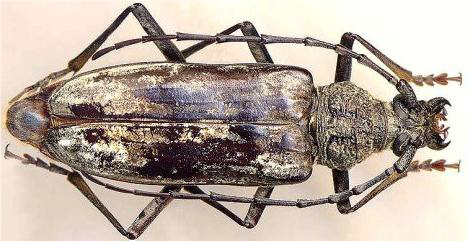 whereas the female antennae are shorter than the body Adults usually leave their pupation cells in April or the beginning of May at an average daily temperature of 20 °C. They are generally active in the evening and night. During the daytime, they hide under the bark, in larval tunnels, in winter tunnels and in other refuges.
whereas the female antennae are shorter than the body Adults usually leave their pupation cells in April or the beginning of May at an average daily temperature of 20 °C. They are generally active in the evening and night. During the daytime, they hide under the bark, in larval tunnels, in winter tunnels and in other refuges.
Damage symptoms:
- Grubs enter the wood and, at the end of the first season of development, make a long (about 25 cm) tunnel upward and then turns to form a downward gallery of 15 cm
- Large emergence holes in trunks and large branches
- Borings at the basis of infested trees
- The adult beetles are conspicuous and may be seen sitting on the trunks
- Branch and tree dieback indicated by wilting and drying of leaves
Natural enemies of stem borer
Predators: Lacewings, ladybird beetles, carabids, syrphids, anthcorid bugs, reduviid bugs, nabid bugs, capsid bugs, big-eyed bugs, earwig, spiders, ground beetle, pentatomid bugs, red ants, preying mantis, Oligota spp., Orius spp., mirid bug, robber fly, black drongo, common mynah etc
Shot-hole borer
Biology:
- Egg: Bark dissections showed that eggs were deposited in small individual chambers on both sides of the mother gallery at regular distances throughout its length. On an average 52 eggs were laid per female, approximately 26 on each side of the mother gallery. The egg is slightly oval, shining, pale white and minute about 0.64 mm in length and 0.48 mm in width. The eggs in the egg niches were covered by the boring dust. The eggs hatched after an incubation period of 5-7 days.
- Grub: The grub on hatching was a minute white dot almost motionless, measuring 0.75 mm in length and 0.45 mm in width. As soon as the feeding started the larva became curved, legless grub and light creamy in colour. A full grown larva was 5.77 mm long and 1.89 mm wide. The head capsule measurements revealed that the larva passed through 5 instars before changing into pupa. The larval phase extended for 38-50 days.
- Pupa: The pupation took place at the ends of the larval galleries in pupal cells. The pupa was soft, white, averaging 4.05 mm in length and 1.60 mm in width. The pupal stage lasted for 6-18 days.
- Adult: The adult emerged from the pupal chamber by tunnelling straight through the bark over it. After emergence, adults flew to the crown of other suitable trees to produce the next generation. The cylindrical adult averages 4.00 mm long and 1.68 mm wide. It has shining black pronotum and dark red brown elytra with declivous abdomen. The adults lived for 45-60 days.
Life cycle
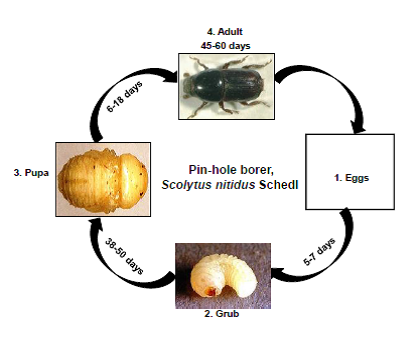
Damage symptoms:
- Grub tunnels in the sapwood on the trunk or branches
- Grub bore into the sap wood and making irregular tunnels.
- Feeding the vascular tissues
- interruption of nutrient and water transport on the tissue
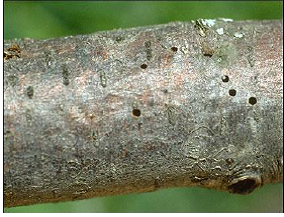
- Drying of terminal shoot in early stage
- Frass comes out from several points and sometimes sap oozes out of the holes
- Wilting of branches or entire tree
- The bark of infested twigs, branches and trunks is perforated with many small round holes. In stone fruits, gum often will appear in and around these holes.
- Pin-hole borer damage usually is limited to weak, declining trees, and infestations frequently hasten tree or limb death
Gypsy moth
Biology:
- Egg: The egg mass is approximately 1.5 inches long and 0.75 inches wide. Eggs are attached to trees, houses, or any outdoor objects. The eggs hatch in spring (April) into caterpillars. Incubation period 5 to 24 days
- Larva: They have five pairs of blue dots followed by six pairs of red dots lining the back. In addition, they are dark colored and covered with hairs. Young caterpillars primarily feed during the day whereas the older caterpillars feed at night. When present in large numbers, the older caterpillars feed day and night. Older caterpillars are approximately 1.5 to 2.0 inches long. Larval period 66-100 days.
- Pupa: In early summer, Gypsy moth caterpillars enter a pupal or transitional stage. The pupae are dark brown, shell-like cases approximately two inches long and covered with hairs. They are primarily located in sheltered areas such as tree bark crevices or leaf litter. Pupal period ranged from 12 to 15 days.
- Adult: Adult Gypsy moths emerge from the pupae in 10 to 15 days. Females have white to cream-colored wings, a tan body, and a two-inch wingspan. Female Gypsy moths cannot fly. Females lay between500 to 1,000 eggs in sheltered areas such as underneath the bark of trees. Both the adult female and male can be identified by the inverted V-shape that points to a dot on the wings. Male and female moths lived for a period of about 3.5 to 6.0 days and 7.0 to 9.0 days. Gypsy moth has only one generation per year.
Life Cycle:
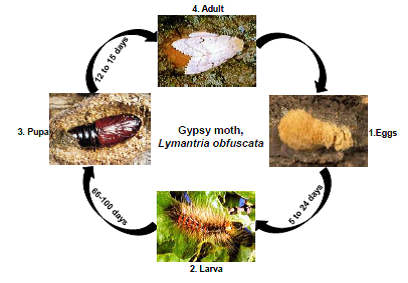
Damage symptoms:
- Caterpillars are gregarious but voracious feeder.
- They eat voraciously on leaves at night time.
- Under heavy infestation entire leaf is eaten sparing only hard vein.
- Defoliation of host completely results in failure of fruit formation.
Natural enemies of gypsy moth:
- Parasitoids: Exorista sp, Drina sp, Apanteles sp, Saracophages sp, Poilania sp, Anilastus sp, Anithomyia sp, Euplectrus sp, Brachymeria sp, Monodontomerus sp, Hyposoter sp, Pimpla sp etc.
- Predators: Lacewings, ladybird beetles, carabids, syrphids, anthcorid bugs, mirid bugs, reduviid bugs, nabid bugs, capsid bugs, spiders, red ants etc
Leaf roller
Biology:
- Egg: Eggs are laid in masses on the twigs of the host and covered by the female with a substance that hardens to create a smooth, hard surface. Larva: First instar larvae bore into the buds of their host plant. Later instars roll or tie leaves together or tie them to fruit. They feed on the leaves, flowers, buds or fruits of the host plant. Later instars roll or tie leaves together or to fruit and partially emerge from the shelter to feed.
- Pupa: Pupation occurs within the larval shelter and adults enclose in 10-12 days. Adult: The adult flight period lasts approximately 3 weeks. The length of the forewings is 6- 10.2 mm for males and 8.5-11.7 mm for females. Adults have a variable forewing colour consisting of combination of reddish brown, dark brown and tan. This species completes a single generation per year
Life Cycle:
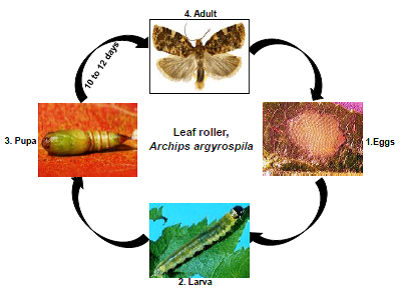
Damage symptoms:
- Buds - Small entry holes in buds, chewed petals and flower parts.
- Blossoms - Petals webbed together, often remaining attached through petal-fall; inner flower parts eaten.
- Leaves - Chewed, rolled and tied together with silk.
- Fruit - Deep irregular holes in small fruit resulting in large russeted scars in mature fruit.
Natural enemies of leaf roller:
Predators:, Lacewings, ladybird beetles, carabids, syrphids, anthcorid bugs, mirid bugs, reduviid bugs, nabid bugs, capsid bugs, spiders, red ants etc
Grey weevil
Biology:
- Egg: Female Myllocerus spp. may lay up to 360 eggs over a 24-day period, and larvae emerge in 3-5 days. Eggs are laid directly on organic material at the soil surface. Eggs are less than 0.5 mm, ovoid and usually laid in clusters of 3-5. The eggs are white or cream-colored at first, then gradually turn brown when they are close to hatching.
- Grub: The grub range in size from 1.09 ± 0.05 mm as first instar grub to 4.0 ± 0.05 mm as ourth instar grub and are beige-white with a reddish brown head. They burrow into the soil where they feed on plant roots for approximately one to two months.
- Pupa: The grub pupates in the soil for approximately one week.
- Adult: Adult weevils vary in length from approximately 6.0 to 8.5 mm; the female weevil is slightly larger than the male by 1.0 to 2.0 mm.
Life Cycle:
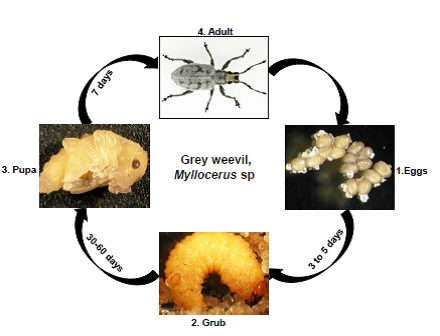
Damage symptoms:
- When adult weevils feed on leaves, they feed inward from the leaf margins (or edges), causing the typical leaf notching.
- There are some instances where the leaf material is almost
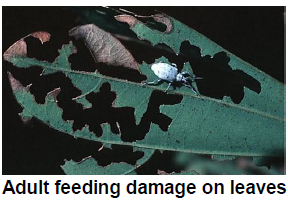 completely defoliated, where the weevil has fed along the leaf veins.
completely defoliated, where the weevil has fed along the leaf veins. - The adults prefer new plant growth.
- Intense feeding by numerous weevils may cause plant decline or stunting.
- Young seedlings may not survive a large amount of feeding damage.
- With healthy plants, however, the feeding damage may be considered cosmetic if the plant recovers.
Codling moth
The rate of development will vary with temperature, proceeding more rapidly in warmer weather and climates. Depending on the climate, codling moth can have two, three, and sometimes four generations per year.
Biology:
- Egg: Eggs are deposited singly on apples and leaves. Each egg is about the size of a pin head and is translucent, gradually darkening as the egg nears hatching. Eggs hatch in six to 14 days, depending on temperature. Within 24 hours of hatching the larvae burrow into the fruit. The first instar larvae have a pink body with a black head and are approximately 1/10 inch in length. The number of eggs laid per female ranges from 30 to 70.
- Larva: After the eggs hatch, young larvae seek out and bore into fruit or developing nuts. Codling moth overwinters as full-grown larvae within thick, silken cocoons under loose scales of bark and in soil or debris around the base of the tree. Larvae are cannibalistic. Full grown larva pinkish or creamy white with brown head and pupates in the soil litter.
- Pupa: After completing development they leave the fruit and drop from the trees to search out pupation sites and continue the life cycle in the soil or on debris under the tree; some crawl back up the tree to pupate in bark crevices. The larvae pupate inside their cocoons in early spring and emerge as adult moths mid-March to early April. The moths are active only a few hours before and after sunset, and they mate when sunset temperatures exceed 62°F.
- Adult: Adults are about 1/2 to 3/4 inch long with mottled gray wings that they hold tent like over their bodies. Their appearance blends well with most tree bark, making them difficult to detect. If you are trapping the adults, you can distinguish codling moth from other moths by the dark, coppery brown band at the tip of their wings. Adult forewings are dark grayish with waxy lines with a copper colored eye like circle toward margin.
Life Cycle:
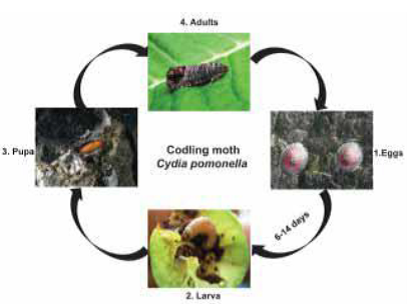
- It is a direct pest and hence causes severe damage to the fruit.
- Neonate larva enters the fruit through calyx and feeds on seed.
- Infested fruits lose their shape and fall prematurely.
- 30 to 70 per cent apple fruits are rendered unmarketable.
Natural enemies of coding moth
- Parasitoid: Trichogramma spp.
- Predators: Parus major, Passer domesticus
San Jose scale
Pest of 700 different species of fruits, shrubs and ornamental plants. Pest is active from March to December. Passes winter black cap stage in tree bark.
Biology:
- Nymph: Female San Jose scales give birth to living young that emerge from under the edge of the scale covering. Each female gives birth to 200-400 nymphs. These tiny yellow crawlers wander in a random fashion until they find a suitable place to settle. Immediately upon settling, the crawlers insert their mouthparts into the host plant and begin feeding and secreting a white waxy material (white cap stage); eventually the waxy covering turns black and is known as the black cap stage. Later the covers turn various shades from gray to black.
- Adult: Immature male and female scales are indistinguishable until the first molt. At this time, the male scale covering begins to elongate, while the females remain circular. Males molt a total of four times. Following the final molt, adult male scales emerge from the scale covering as tiny, yellow winged insects. They mate with the females who remain under the scale covering. Female insect body covered with grey scales. Yellow lemon coloured female is visible when covering is lifted. Female scales are very prolific and over a 6-week period can produce approximately 400 young. San Jose scale produce living young called crawlers; most other scales produce eggs. Crawlers move around for a short period in search of a suitable place to settle. It takes 25 days for males to mature and 31 days for females Five to six generations in a year.
Life Cycle:

Damage symptoms:
- Nymph and female scales attack all above ground parts.
- Feeding site turns into a characteristic purplish red colour.
- Initially growth of plant is checked but as scale increases in number plant may die.
- Fruits will have distinct “measles” spots on the surface.
Natural enemies of San Jose scale
- Parasitoids: Encarsia sp, Aphytis sp
- Predators: Ladybird beetle
IPM for Walnut
To know the IPM practices for Walnut, click here.
Source: NIPHM, Directorate of Plant Protection, Quarantine & Storage
Last Modified : 3/31/2020
This topic provides information about Apricot- In...
This topic provides information about Pear- Insec...
This topic covers information about Description of...
This topic provides information about Cherry- Inse...
